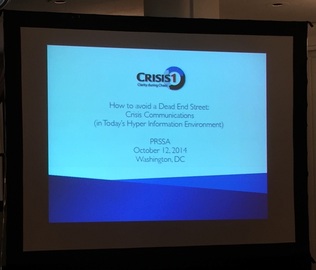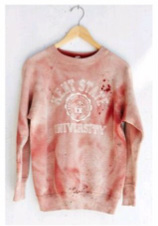 By Jessica Barone At PRSSA National Conference this year, I learned about crisis management with the help of Roger Frizzell, chief communications officer for Carnival Corporation, and Mike Flanagan, partner at the LDWW group. They discussed how to handle a crisis before (which can be difficult), during, and after the crisis. “It’s how you manage the issues along the way,” Frizzell said. You may not know when a crisis is coming; however, you can get yourself prepared for tomorrow’s crisis. It’s all about the relationships you make with the media before a crisis happens that can either help you or hurt you. It is important to handle the reputation of the company after the crisis. You need to pick someone to take credit for the change: a change maker. This is critical in post-crisis management. You need to have a “pillow of good news,” or positive media coverage, so that in the instant something bad happens, it will help soften the blow. You need to change the conversation with the media, enlist third parties because their voices are more meaningful and measure everything because you can never let research fall behind in importance. Top 10 post-crisis steps:
Public relations can really impact a brand if done correctly. When Carnival had an incident where one of its ship’s engines caught on fire, for example, it hurt its brand and reputation. It was known as “the poop cruise,” but Carnival came up with a game plan to regain its publics’ trust. Game plan:
In this industry it is important to take crisis management seriously. Preparation and research is key in helping a company or brand recover from a crisis. The job is never done after a crisis. “In this business we are always dancing,” Flanagan said.
0 Comments
 by Casey Braun One of the noblest things a person can do is help someone else in a time of crisis. That is why I think crisis communication is one of the most vital, exciting and rewarding areas of public relations. In the session “How to Avoid a Dead-End Street: Crisis Communications” at the PRSSA National Conference, APCO Worldwide Executive Director Kent Jarrell and Crisis1 President Pat Philbin spoke about their experiences in the crisis and issues management field. Both spoke about how in a world where incidents like the Virginia Tech shooting and other salacious news are becoming commonplace, it is more vital than ever for organizations to be vigilant and prepared. Further, it is important for practitioners to understand the fundamentals of crisis communication even if they think they will never need to use them. Philbin discussed the PESTEL framework for analyzing internal and external factors that can affect an organization. PESTEL stands for political, economic, social, technological, environmental and legal factors, all of which public relations counselors should be constantly researching and analyzing for risks and threats. Philbin went on to discuss how in a communication landscape like ours, it is important for practitioners to be able to engage in conversation about these factors. “In this politically correct age we live in, it’s almost impossible to have good discourse about anything,” Philbin said. It is the job of public relations practitioners to begin discourse about key issues in their organizations to help identify issues and plan for crises. Jarrell discussed different methods for predicting crises, including scenario mapping using a four quadrant model and risk ranking. “If you can determine how the risk will be assigned to certain stakeholders…what’s in the top right quandrant…is the most likely occurrence and could be the most catastrophic. That’s preplanning. But it’s the same model you use if a crisis breaks,” Jarrell said. Both speakers emphasized a need for sincerity, protecting people first in a crisis and facilitating knowledge and understanding. “In our business, integrity is the only currency you have,” Philbin said. “People are generally forgiving of mistakes, but people won’t forgive if they perceive that [organizations] don’t care or aren’t doing all they can… People want to know that you care before they care what you know.” Both provided more tips for communicating during a crisis, such as:
Both speakers concluded their portions discussing the most important element of effective crisis communication: telling the truth. “Communication has to be directly to policy or the truth… It starts at the top. You have to have a CEO or an effective management team that understands that without having a communications component, we are at risk,” Jarrell said. “Trust equals 1) doing the right things well and 2) communicating them well,” Philbin said. Basic crisis communication principles seem relatively basic. However, many companies and executives still get themselves in trouble by not understanding the basic tenets of what publics really want to know from a company and the best ways to communicate that information. Research, pre-planning, issues scanning and telling the truth are essential to preserving an organization’s reputation during a crisis.  Image Courtesy: Washington Redskins Image Courtesy: Washington Redskins by Tim Roberts, Lecturer When it comes to brand ambassadors, National Football League fans are hard to beat. On any given fall Sunday, hordes of logo-clad, face-painted followers pay top dollar to see their wishes fulfilled or hopes dashed. And, as any Cleveland Browns fans would agree, poor on-field performance doesn’t necessarily translate into a loss of affection. We almost instinctively keep coming back for more. The NFL and its 32 teams have financially capitalized on that seemingly unshakeable brand loyalty, but this year a series of ethically questionable decisions and reactions to players’ criminal acts have placed league officials in full crisis management mode and caused some to call for an NFL Boycott. While the finger-pointing over who knew what when continues in the Ray Rice-Roger Goodell saga, the lesson to be taken away is a no-brainer for any PR practitioner—tell the truth as you know it and when you know it to maintain trust and credibility. What's in a name? But a lesser-known transparency issue involving one NFL team can provide even more valuable ethics lessons, especially to aspiring PR pros. For several years, the Washington Redskins organization has been fending off criticism of the team name, with a growing number of groups calling it racist and offensive and demanding a name change. Owner Dan Snyder has not budged publicly in his support for the name. Last July, a website called Redskins Facts was launched to defend the name, with former Redskins players billed as a steering committee. The About Us section portrayed the site as a grassroots effort by team supporters. But on July 29, the online news site Slate posted a well-researched article linking the site to the Redskins and Burson-Marstellar, a public relations agency known for its crisis management work. The authors tracked the site’s source code to a Burson-Marstellar site, and, in addition, their reporting revealed the Redskins Facts site had the look and feel of other Burson-Marstellar crisis management site templates. A team spokesman danced around the question whether the Redskins was involved with the site and Burson-Marstellar did not even respond to Slate. After the story appeared, however, both Burson-Marstellar and the Redskins acknowledged their involvement in a Reuters article published July 30, with the agency saying through a spokesman it was representing the Redskins. While astroturfing may be too strong of a word considering both the team and the agency acknowledged their roles after the Slate article appeared, the initial lack of transparency and fudging by the Redskins and especially Burson-Marstellar is disturbing. It’s easy to criticize the agency for not being open with Slate about its involvement with the team and the website, as well as not insisting the Redskins make clear on the site its relationship. The Disclosure of Information section in the PRSA Code of Ethics covers that ethical misstep with clarity. What does this mean for PR ethics? As PR practitioners, we advocate for our organizations and clients. But we also are supposed to provide wise, ethical, and informed counsel. Both ethically and strategically, the Burson-Marstellar agency didn’t do the job. Research is the alpha and omega of public relations, and the agency should have insisted on conducting objective, scientific and targeted research to gauge what Redskins’ fans think of the name and the controversy. (The Redskins Facts site does link to ESPN and Washington Post polls showing a plurality of support for the name.) If the research was in line with the other polls and showed fans supported the current name or were apathetic about it, the agency would be obligated to report that. Then, it should take the ethical high road and insist the team be transparent about who was responsible for the website. If the team resisted, it would be appropriate for Burson-Marstellar to turn down the website assignment. It wouldn’t be the only agency that ever “fired” a client over ethical issues. PR pros need to start taking ethical inventories of themselves, their organizations, and their clients. And when they do so, they need to remember the old adage, “When you lay down with dogs, you get fleas.”  (Photo: WKYC-TV) (Photo: WKYC-TV) by Steph Martoccia Social media and online news outlets are buzzing about the Urban Outfitters sweatshirt that features the Kent State University logo and what appears to be splattered blood, alluding to the May 4, 1970, shooting on campus where four individuals were killed. Thousands of people are tweeting their outrage, making both “Kent State” and “Urban Outfitters” trending topics on Twitter. The worst part about this whole situation is Urban Outfitters has either lied to the public about the motive behind its sweatshirt, or its designers are very ill-informed about historic events. Urban Outfitters apologized for the outrage the sweatshirt caused. The company released this statement on the morning of Sept. 15: "Urban Outfitters sincerely apologizes for any offense our Vintage Kent State Sweatshirt may have caused. It was never our intention to allude to the tragic events that took place at Kent State in 1970 and we are extremely saddened that this item was perceived as such. The one-of-a-kind item was purchased as part of our sun-faded vintage collection. There is no blood on this shirt nor has this item been altered in any way. The red stains are discoloration from the original shade of the shirt and the holes are from natural wear and fray…" From a public relations standpoint, this statement is not good. There are hundreds of universities in the nation Urban Outfitters could have placed on this sweatshirt, yet the company wants its publics to believe it was an accident Kent State was featured on a faux-bloodstained sweatshirt. Kent State colors are blue and gold; why would Urban Outfitters choose red for this sweatshirt? Urban Outfitters should not try to cover up its mistake; it makes for a shallow apology. It should be telling the truth behind the motive of this shirt instead of saying the “sun-faded” discoloration has led to the appearance of blood splatter. The validity of the statement is hard to believe, making this a public relations catastrophe. Kent State released a statement as well, stating: "We take great offense to a company using our pain for their publicity and profit. This item is beyond poor taste and trivializes a loss of life that still hurts the Kent State community today. We invite the leaders of this company as well as anyone who invested in this item to tour our May 4 Visitors Center, which opened two year ago, to gain perspective on what happened 44 years ago and apply its meaning to the future." The Urban Outfitters spokespeople could learn a thing or two from Kent State media relations pros. This statement not only demonstrates a clear, concise reaction to the event, it also promotes the May 4 Visitors Center, something that may not have gained any national media attention otherwise.
The release of this sweatshirt is truly offensive to the Kent State community, and the way Urban Outfitters has chosen to handle this dilemma is testing the loyalty of its remaining customers. Many people have declared via social media they will never shop at this store, again. Whether their statements are true or not, it is clear this company has to work on its communications before it is able to regain public trust. |
Archives
February 2024
Categories
All
|
 RSS Feed
RSS Feed
